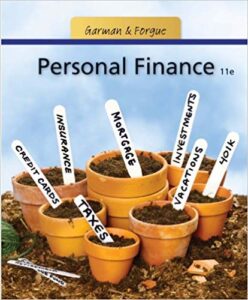Description
Test Bank For Personal Finance 11th Edition by E. Thomas Garman
Chapter 6—Building and Maintaining Good Credit
TRUE/FALSE
1.Credit is a term used to describe any situation in which goods, services, or money is received in exchange for a promise to repay at a future date.
ANS: T PTS: 1 DIF: easy REF: p. 171
2.The most commonly used forms of credit by consumers are loans and credit cards.
ANS: T PTS: 1 DIF: easy REF: p. 171
3.Loans generally require equal payments over a set period of time.
ANS: T PTS: 1 DIF: moderate REF: p. 171
4.Convenience use of credit is common.
ANS: T PTS: 1 DIF: easy REF: p. 171
5.Credit cards allow repeated use of credit as long as you make the minimum monthly payment.
ANS: T PTS: 1 DIF: easy REF: p. 171
6.Credit cards allow repeated use of credit as long as equal monthly payments are maintained over a set period of time.
ANS: F
the payments will vary according to the balance of the debt on the account.
PTS: 1 DIF: moderate REF: p. 171
7.Credit cannot be used to own expensive products sooner.
ANS: F
this is why most people use credit
PTS: 1 DIF: easy REF: p. 172
8.Credit card blocking is the process whereby the merchant may notify the credit card issuer to put a hold on your account for the anticipated total amount of the charge.
ANS: T PTS: 1 DIF: moderate REF: p. 172
9.Advantages of credit use include increased protection against rip-offs and frauds.
ANS: T PTS: 1 DIF: moderate REF: p. 172
10.People can use credit to take advantage of “free” credit.
ANS: T PTS: 1 DIF: easy REF: p. 172
11.Taking on excessive debts early in life may compromise your goal of being financially successful.
ANS: T PTS: 1 DIF: easy REF: p. 173
12.Convenience use of a credit card is justified only if the card balance is paid in full by the end of the year.
ANS: F
convenience usage should be paid off monthly.
PTS: 1 DIF: moderate REF: p. 171
13.Credit use increases future buying power.
ANS: F
it decreases future buying power.
PTS: 1 DIF: easy REF: p. 172
14.Dishonest or deceptive practices by lenders taking advantage of a borrower’s lack of understanding of credit matters is referred as “bottom feeding.”
ANS: F
this practice is referred to as “predatory lending.”
PTS: 1 DIF: moderate REF: p. 173
15.Interest is the price of credit.
ANS: T PTS: 1 DIF: easy REF: p. 173
16.The lower the annual percentage rate of interest (APR), the higher the cost of credit.
ANS: F
the lower the APR the lower the cost of credit.
PTS: 1 DIF: easy REF: p. 173
17.The APR can be used to compare credit contracts with different time periods, finance charges, repayment schedules, and amounts borrowed.
ANS: T PTS: 1 DIF: moderate REF: p. 173
18.The Truth in Lending Act requires lenders to state the finance charge both in dollars and as an annual percentage rate (APR).
ANS: T PTS: 1 DIF: easy REF: p. 173
19.The APR expresses the cost of credit on a monthly basis as a percentage rate.
ANS: F
the APR expresses the cost of credit on a yearly basis as a percentage rate.
PTS: 1 DIF: moderate REF: p. 173
20.When comparing loans from two or more sources you want to focus on the lowest monthly payment.
ANS: F
you should focus on the lowest APR.
PTS: 1 DIF: moderate REF: p. 173

Reviews
There are no reviews yet.